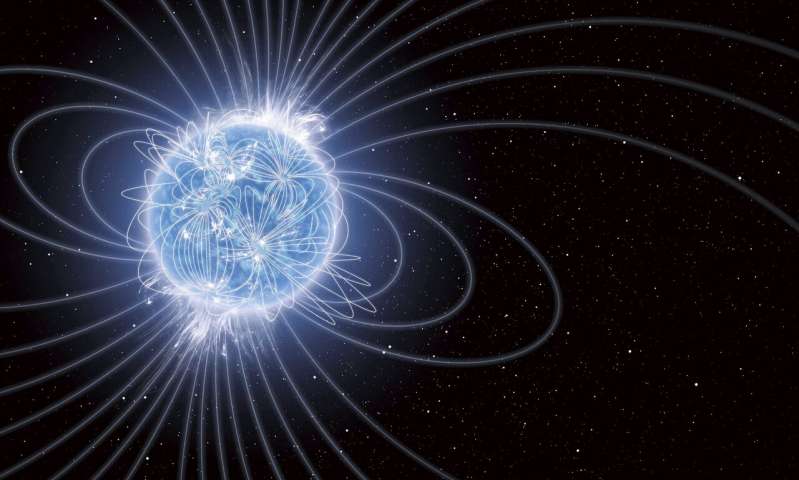Unpredictable space radio bursts may stem from asteroids around magnetic stars

Mysterious repeating bursts of radio waves that fire in random patterns might come from neutron stars blasting asteroids with magnetic winds that travel at nearly the speed of light, a new study finds.
Fast radio bursts, or FRBs, are intense pulses of radio waves that can give off more energy in a few thousandths of a second than the sun does in nearly a century. Scientists only discovered FRBs in 2007, and much remains unknown about their origins because of their brief existence.
Since fast radio bursts are rare and bright — the're visible across millions or even billions of light-years — researchers have often assumed they originate from cataclysmic events, such as stellar flares or colliding neutron stars. (Neutron stars are corpses of stars that died in catastrophic explosions known as supernovas; the gravity of these stellar remnants is powerful enough to crush protons and electrons together to form neutrons.)
Related: Scientists detect strange 'fast radio burst' from our own Milky Way
The mystery of fast radio bursts deepened when scientists discovered the first repeating fast radio burst in 2016. When astronomers see repeating patterns in celestial events, they often think celestial mechanics might play a role — say, a planet completing an orbit around its star, or a fast-spinning neutron star known as a pulsar that blasts radio waves from its magnetic poles, flashing like a lighthouse as seen from the perspective of Earth.
But the radio bursts in the 2016 event, strangely, had random timing.
Asteroids and neutron stars
Now researchers suggest that asteroids orbiting neutron stars might help explain at least some repeating fast radio bursts, even those with random timing. The key to this concept is that strong winds of particles often blow outward not just from live stars like our sun but from dead ones as well, such as pulsars. Since pulsars are highly magnetic, their winds are too, and since pulsars spin rapidly, completing up to hundreds of revolutions per second, their winds can blast out at relativistic speeds — that is, at nearly the speed of light.
Get the Space.com Newsletter
Breaking space news, the latest updates on rocket launches, skywatching events and more!

The scientists calculated that an object orbiting a pulsar — perhaps an asteroid — would carve a wake in the pulsar's wind. An electric current would circulate around this wake, and when the pulsar's wind crosses this wake, the researchers calculated, the resulting magnetic disturbances would generate a very narrow and extremely intense beam of radio waves.
The researchers noted that asteroids 0.6 to 6 miles wide (1 to 10 kilometers) orbiting their pulsars at one astronomical unit (AU) or closer would generate fast radio bursts of the intensities detected to date, especially if the pulsars had powerful magnetic fields. (One AU is the average distance between Earth and the sun, which is about 93 million miles or 150 million kilometers.)
The scientists noted that asteroids zipping through a pulsar's highly magnetic, superfast winds would continuously generate intense radio beams. But astronomers on Earth would only see these beams as bursts, during the rare instances when the neutron stars, asteroids and telescopes on Earth happened to line up.
"The short duration of the radio bursts is caused by the short time during which we observers are in the radio beam," study lead author Fabrice Mottez, an astrophysicist at the French National Center for Scientific Research and the Paris Observatory, told Space.com.
Facing the magnetar winds
The researchers also explored what repeating fast radio bursts might look like when created by asteroids flying through the highly magnetic, highly relativistic winds of magnetars, a rare type of neutron star that are the strongest magnets in the cosmos. They found asteroids around magnetars could generate fast radio bursts about a thousand times more powerful than the strongest one seen to date.

If this explanation is correct, the random patterns in repeating fast radio bursts are likely caused by a cluster of asteroids interfering with the neutron star's winds, the scientists noted, rather than a single rock. "In our model, there are a few hundred asteroids, each of them having its own beam," Mottez said. A moon-laden exoplanet around a pulsar or magnetar could also explain the phenomenon, the researchers noted.
Gravitational interactions between asteroids in swarms might lead to irregularities in each of their orbits that would also lead to unevenness in the timing of any bursts that astronomers detected, Mottez said.
In addition, the magnetic fields of pulsar and magnetar winds would fluctuate regularly in time with the rates these neutron stars spin at, which in turn would influence the directions of the radio beams from any orbiting object, potentially making the timing look more random, he added. Another cause of randomness, maybe the most important, would be wind turbulence, he said.
The scientists detailed their findings in a paper accepted on Oct. 7 by the journal Astronomy and Astrophysics, which was also posted to the preprint server arXiv.org.
Follow Charles Q. Choi on Twitter @cqchoi. Follow us on Twitter @Spacedotcom and on Facebook.
Join our Space Forums to keep talking space on the latest missions, night sky and more! And if you have a news tip, correction or comment, let us know at: community@space.com.

Charles Q. Choi is a contributing writer for Space.com and Live Science. He covers all things human origins and astronomy as well as physics, animals and general science topics. Charles has a Master of Arts degree from the University of Missouri-Columbia, School of Journalism and a Bachelor of Arts degree from the University of South Florida. Charles has visited every continent on Earth, drinking rancid yak butter tea in Lhasa, snorkeling with sea lions in the Galapagos and even climbing an iceberg in Antarctica. Visit him at http://www.sciwriter.us









